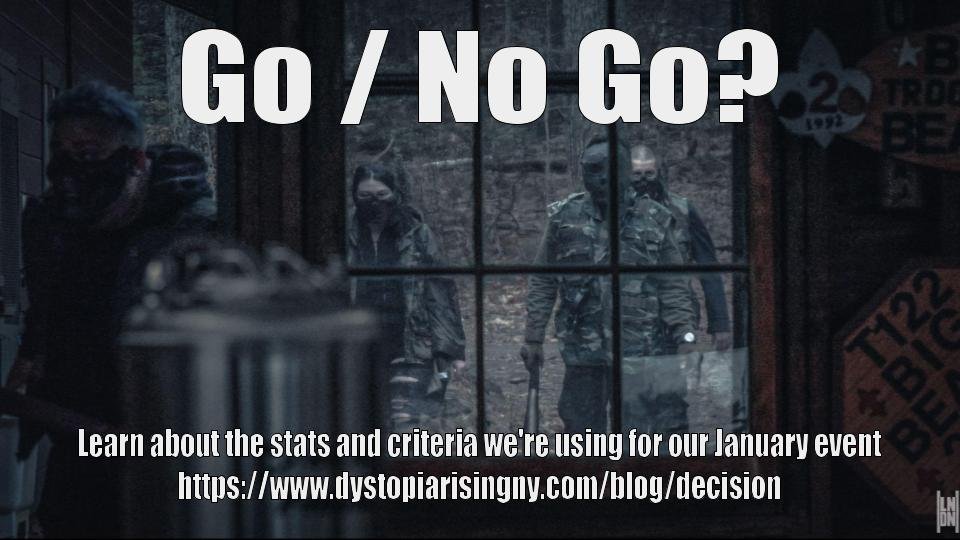This post is about transparency - we want to address the Omicron variant of COVID-19 and how we’re managing risk in regards to it. Over the past week, we’ve released a number of policies to manage risk… now we’re going to tie our efforts together and explain how we will make our decisions.
First, a short description of how we approach risk management. The only safe larp is the larp that never happens; every larp has the risk of harm. Our job as event runners is to reduce risk to an acceptable level, and communicate that risk to our players. Once we’re comfortable with the risk of the event, we invite people to participate, and they make a risk-informed decision. To do this, we identify hazards, determine their likelihood and severity, and implement controls to reduce that likelihood and severity.
In regards to COVID, we have a clear risk with a bunch of data - we can go to various websites (including the CDC and New York State Department of Health) and find statistics of all sorts. Because of this, we can identify controls that will reduce the likelihood and severity of COVID-19 transmission at our event. The single most effective control is an up-to-date vaccination. Prior to the emergence of the Omicron variant, Dystopia Rising New York (DRNY) relied on the effectiveness of vaccinations to control the risk of COVID-19 transmission. A good review of the effectiveness of vaccines was released by the Massachusetts Department of Health last month, which showed that vaccinations prevent hospitalization or death in 97% of all breakthrough cases, and that vaccinated people were 5 times less likely to be infected with COVID-19 (with a booster shot, people were 31 times less likely).
This is what we would consider our baseline risk: we accept this risk until the probability or severity of the risks change. The Omicron variant changes this risk in two ways:
Increased transmission rate in the general population make it more likely that someone will contract COVID-19 at an event.
Vaccines seem to offer less protection against the Omicron variant than they do against other variants of COVID-19.
Our Enhanced COVID-19 Protections seek to address these risks:
We’re doing everything we can to make sure as many people are boosted, in addition to vaccinated. As of Friday, January 7th, we’re at 71% boosted for our next event, and we are expecting that to grow. Getting boosted returns the protection vaccines provide against Omicron back to acceptable levels.
We’re instituting other policies (such as encouraging mask use and testing non-boosted individuals) to reduce the likelihood of transmission.
We’re monitoring several keys statistics, primarily the 7-day rolling positivity rate in New York State.
Why the 7-day rolling positivity rate? Because it’s readily available, and provides us trend information. For example, here’s the statistics for the last five weeks:
December 3rd, 2021: 4.8% (up by 0.9%)
December 10th, 2021: 4.6% (down 0.2%)
December 17th, 2021: 6.3% (up 1.7%)
December 24th, 2021:11.0% (up 4.7%)
December 31st, 2021: 19.8% (up 8.8%)
January 7th, 2022: 22.2% (up 2.4%)
We’re also looking at the NYC 7-day rolling positivity rate, because it seems to lead the New York State rate (i.e. what happens in the City happens a few days before the rest of the state). Here’s what the NYC rate looks like as of January 6th…
What we see is what we’re expecting: the positivity rate increases rapidly, and then declines rapidly (as was the case in South Africa). However, there’s a lag in the reporting (you can see the gray area on the map). What we really want to see is the data around Friday, January 21st - that will give us a week of looking at what the trend is when we’ve removed the holidays and given the spike a chance to die down. If we’re trending downward (i.e. we see a slight decline in the 7-day rolling average this week, and 5 - 10% decline the week after), we’ll feel confident we’re in the “back half” of the spike, and that our controls - a highly boosted population - will work. If not… then we have to rethink our risk mitigation.
One question is “why have they not called off the event?” First, cancellation is only one risk management tool, and we have other controls in place. Second, we want to look at the data. At this point, there’s little reason (from a risk control perspective) to cancel the event weeks in advance when we can wait and check the data. Our primary concern is our travelers who have bought plane tickets, but as the vast majority of them are flying an airline that doesn’t have change fees (and have not been contacted by any travelers in regards to this concern), we do not feel pressure to make the decision right now.
However, there are factors other than COVID-19 statistics and controls that go into a risk-informed decision for our participants. One is mental health. Uncertainty leads to anxiety, and right now, we’ve had two years of uncertainty. We’re going to continue to prepare for the January event while we monitor the situation, and will continue to provide you updates. We ask that you make a decision that you’re comfortable with, and if you have questions about our process, contact us directly.
Thanks, and still planning on seeing you in January (numbers willing)!


